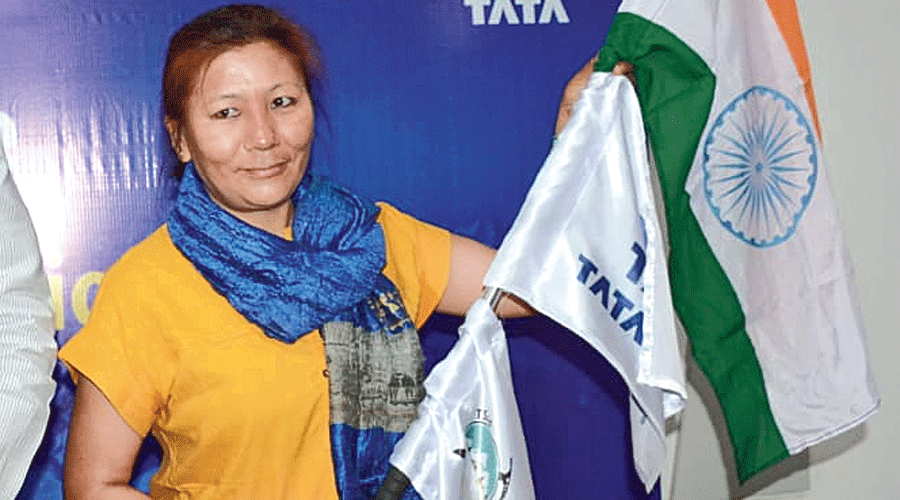Asmita Dorjee was born in 1984, the year her father had accompanied Bachendri Pal as her sherpa when she became the first Indian woman to summit Mt Everest. Thirty-eight years since then, Asmita is preparing for another Himalayan feat, aiming to become the first woman in the country to climb the world’s highest peak without supplemental oxygen.
Asmita, whose father Ang Dorjee passed away during another mission, came to India from Nepal in 1989 after the death of her mother, and was brought up by Pal as a family member. Asmita was born in Thesu, a tiny village above Namache Bazaar in the Everest region of Nepal.
Asmita, a Jamshedpur resident and an Indian citizen now, will be supported in her mission by the Tata Steel Adventure Foundation (TSAF), founded by Pal.
Asmita, a senior instructor with the TSAF, is preparing for a climb that is considered highly perilous without supplemental oxygen because of the extreme thin air. The expedition route beyond 8,000ft is considered a “death zone” because of low oxygen levels, strong winds and extreme cold. Only a handful of people in the world have climbed Mt Everest without supplemental oxygen.
“Due to very low oxygen availability, climbers need supplemental oxygen from Camp 3, which is 7,100m metres above sea level, to survive and return safely. She will leave for Nepal on April 3, 2022. The TSAF was planning to send Asmita to Mt Everest in 2020 and 2021. However, the expedition got postponed because of the Covid-19 pandemic,” TSAF head Hemant Gupta said.
In 2016, Melissa Arnot became the second American woman to summit Mount Everest without supplemental oxygen and the first who survived the descent. Another American woman, Francys Arsentiev, had reached the summit without supplemental oxygen in 1998 but died during the descent.
“An expedition to the highest summit requires a lot of active preparations, which I started in April 2019. I have been training for the last three years with focus on improving my strength, endurance and stamina, keeping the no-oxygen attempt in mind. Additionally, I am cycling and running for long distances and trail running at the TSAF base camp at Uttarkashi and the Dalma hills in Jamshedpur,” Asmita said.
TSAF chairman and Tata Steel vice-president (corporate services) Chanakya Chaudhary, who has flagged off Asmita’s expedition, said: “We are delighted to launch another attempt (to summit) Mt Everest and wish the best of luck and safe climb to Asmita Dorjee for her attempt to summit Mt Everest without supplementary oxygen. The attempt promises to be an ultimate showcase of human endurance and her indomitable spirit. The Foundation, through its unique proposition and sustained endeavours, will continue to promote adventure sports in the country and inspire generations.”
The TSAF helped Asmita to complete her Basic Mountaineering Course in 2001 and the Advanced Mountaineering Course in 2003. Then she was employed as instructor at the TSAF to conduct outdoor leadership courses and expeditions.
“She is a strong mountaineer with many feathers in her mountaineering cap. She has climbed and attempted more than eight peaks above 6,000m. She has successfully climbed Mt Satopanth (7,075m), Mt Dharamsura (6,420m), Mt Gangotri 1 (6,120m), Mt Stok Kangri (6,070m), Kang Yatse 2 (6,270m) and Djo Zongo (6240m). She has summited Mt UT Kangri (6,030m) in winter and attempted Mt Stok Kangri in winter and reached 5,700m,” a TSAF official said.
Asmita said: “These expeditions were the building blocks of my mountaineering journey.”
Asmita is scheduled to fly to Kathmandu on April 3, after which she will leave for the Everest Base Camp on April 6. The journey will take around eight days. At the camp, she will spend a few days to acclimatise. She will then proceed towards Lobuche East, which is located at 6,119m in the same region.
Asmita will return to the base camp for further acclimatisation for around one month. She will then have to wait for good weather, which is expected between May 15-25, to attempt the summit.
The TSAF has so far supported and trained 10 climbers who have successfully summited Mt. Everest. They are Premlata Agarwal in 2011, R.S. Pal, Meghlal Mahato, Binita Soren, Arunima Sinha and Susen Mahato (2013), Hemant Gupta (2017) and Sandeep Tolia, Poonam Rana and Swarnlata Dalai (2018).











